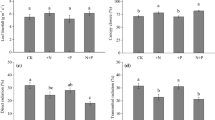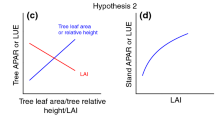Summary
Seedlings of five tropical trees, Cecropia obtusifolia, Myriocarpa longipes, Piper auritum, Senna multijuga and Trichospermum mexicanum, were grown both as individuals, and in competition with each other at ambient (350) and two levels of elevated CO2 (525 and 700 μl l-1) for a period of 111 days. Growth, allocation, canopy architecture, mid-day leaf water potential and soil moisture content were assessed three times over this period for individually grown plants, and at the end of the experiment for competitively grown plants. In addition, leaf photosynthesis and conductance were assessed for the individually grown plants midway through the experiment, and light profile curves were determined for the competitive arrays at three stages of development. Elevated CO2 did not affect photosynthesis or overall growth of the individually-grown plants but did affect canopy architecture; mean canopy height increased with CO2 in Piper and Trichospermum and decreased in Senna. Stomatal conductance decreased slightly as CO2 increased from 350 to 525 μl l-1 but this had no significant effect upon whole plant water use of leaf water potential. Soil moisture content for the individuals increased marginally as CO2 increased, but this did not occur in the competitive arrays. There was a marked effect of CO2 upon species composition of the competitive arrays; Senna decreased in importance as CO2 increased while Cecropia, Trichospermum and Piper increased in importance. Stepwise regression analysis using competitive performance as the independent variable, and the various morphological and physiological parameters measured on the individually grown plants as independent variables, suggested that canopy height was the single most important variable determining competitive ability. Also significant were photosynthetic rate (particularly at low light levels) and allocation to roots early in the experiment. Light profiles in the canopy revealed that less than 15% of incident light penetrated to the level of mean canopy height. Results suggest that competition for light was the major factor determining community composition, and that CO2 affected competitive outcome through its affect upon canopy architecture.
Similar content being viewed by others
References
Bazzaz FA (1987) Experimental studies on the evolution of niche in successional plant populations: a synthesis. In: Gray AJ, Crawley MJ, Edwards PJ (eds) Colonization, Succession and Stability, pp 245–272
Bazzaz FA, Carlson RW (1984) The response of plants to elevated CO2. I. Competition among an assemblage of annuals at two levels of soil moisture. Oecologia 62:196–198
Bazzaz FA, Garbutt K (1988) The response of annuals in competitive neighborhoods: Effects of elevated CO2. Ecology (in press)
Bazzaz FA, Garbutt K, Williams WE (1985) Effect of increased atmospheric carbon dioxide concentration on plant communities. In: Strain BR, Cure JD (eds) Direct Effects of Increasing Carbon Dioxide on Vegetation. United States Department of Energy, National Technical Information Service, Springfield, Virginia, pp 155–170
Bingham GE, Coyne GE, Kennedy RB, Jackson WL (1980) Design and fabrication of a portable minicuvette system for measuring leaf photosynthesis and stomatal conductance under controlled conditions. UCRL-52895, Lawrence Livermore National Laboratory, P.O. Box 5507. Livermore, CA 94550, p 64
Caemmerer S von, Farquhar GD (1981) Some relationships between the biochemistry and photosynthesis and the gas exchange of leaves. Planta 153:376–387
Carlson RW, Bazzaz FA (1980) The effects of elevated CO2 concentrations on growth, photosynthesis, transpiration, and water use efficiency of plants. In: Singh JJ, Deepak A (eds) Environmental and Climatic Impact of Coal Utilization. Academic Press, New York, pp 609–623
Carlson RW, Bazzaz FA (1982) Photosynthetic and growth response to fumigation with SO2 at elevated CO2 for C3 and C4 plants. Oecologia 54:50–54
Cure JD (1985) Carbon dioxide doubling responses: a crop survey. In: Strain BR, Cure JD (eds) Direct effects of increasing carbon dioxide on vegetation. United States Department of Energy report DOE/ER-0238, pp 99–116
Firbank LG, Watkinson AR (1987) On the analysis of competition at the level of the individual plant. Oecologia 71:308–317
Harper JL (1977) Population Biology of Plants. Academic Press, London
Mooney HA, Field C, Vásquez-Yanes C, Chu C (1983) Environmental controls on stomatal conductance in a shrub of the humid tropics. Proc Natl Acad Sci 80:1295–1297
Oberbauer SF, Strain BR, Fetcher N (1985) Effect of CO2-enrichment on seedling, physiology and growth of two tropical tree species. Physiologia Plantarum 65:352–356
Oechel W, Strain BR (1985) Native species responses to increased carbon dioxide concentration. In: Strain BR, Cure JD (eds) Direct Effects of Increasing Carbon Dioxide on Vegetation, United States Department of Energy, National Technical Information Service. Springfield, Virginia, pp 117–154
Pacale SW, Silander JA Jr (1985) Neighborhood models of plant population dynamics. I. Single-species models of annuals. Am Nat 125:385–411
Paez A, Hellmers H, Strain BR (1984) CO2 enrichment and water interaction on growth of two tomato cultivars. Journal of Agricultural Science 102:687–693
Reynolds JF, Acock B (1985) Modeling approaches for evaluating vegetation responses to carbon dioxide concentration. In: Strain BR, Cure JD (eds) Direct Effects of Increasing Carbon Dioxide on Vegetation. United States Department of Energy, National Technical Information Service. Springfield, Virginia, pp 33–52
Rzedowski J (1978) Vegetacion de Mexico. Editorial Limusa, Mexico. p 432
Sasek TW, DeLucia EH, Strain BR (1985) Reversbility of photosynthetic inhibition in cotton after long-term exposure to elevated CO2 concentrations. Plant Physiology 78:619–622
Sionit N, Strain BR, Hellmers H, Riechers GH, Jaeger CH (1985) Longer-term atmospheric CO2 enrichment affects and the growth and development of Liquidambar styraciflua and Pinus taeda seedlings. Can J For Res 15:468–471
Weiner J (1982) A neighborhood model of annual plant interference. Ecology 63:1237–1241
Whittaker RH (1975) Communities and Ecosystems. 2nd Edition, MacMillan Publishing Co., Inc., New York
Woodward FI (1987) Stomatal numbers are sensitive to increases in CO2 from preindustrial levels. Nature 327:617–618
Zangerl AR, Bazzaz FA (1984) The response of plants to elevated CO2. II. Competitive interactions between annual plants under varying light and nutrients. Oecologia 62:412–417
Author information
Authors and Affiliations
Additional information
This study was supported by a grant from the US Department of Energy
Rights and permissions
About this article
Cite this article
Reekie, E.G., Bazzaz, F.A. Competition and patterns of resource use among seedlings of five tropical trees grown at ambient and elevated CO2 . Oecologia 79, 212–222 (1989). https://doi.org/10.1007/BF00388481
Received:
Issue Date:
DOI: https://doi.org/10.1007/BF00388481




